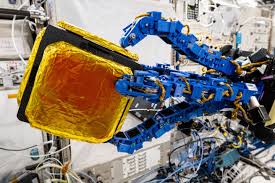Blue, flexible arms on an Astrobee free-flying robot are shown grasping a “capture cube.” These innovative grippers have successfully demonstrated the ability to autonomously locate and seize objects—a capability that could prove invaluable for removing space debris and servicing satellites in low Earth orbit.
Developed at NASA’s Ames Research Center in Silicon Valley, the Astrobee system was created for operations inside the International Space Station. It comprises three cube-shaped robots—Bumble, Honey, and Queen—along with specialized software and a recharging docking station.
The robots are propelled by electric fans, which allow them to navigate freely in the microgravity environment of the station. They use cameras and sensors to detect and understand their surroundings, and they are equipped with a perching arm that lets them secure themselves to handrails or grasp objects to save energy.





